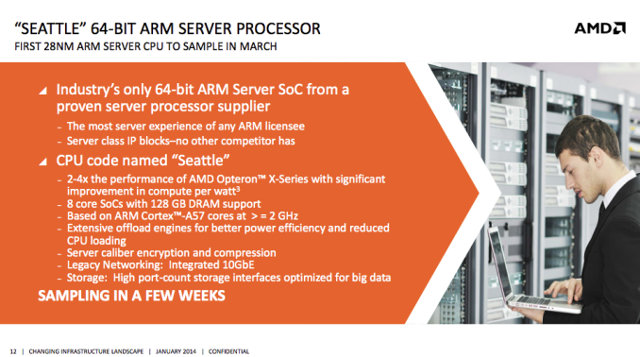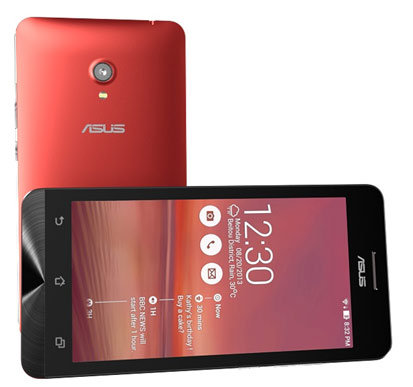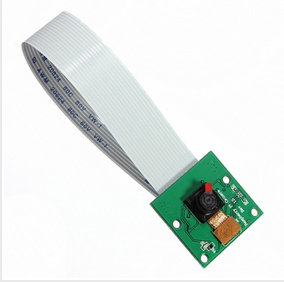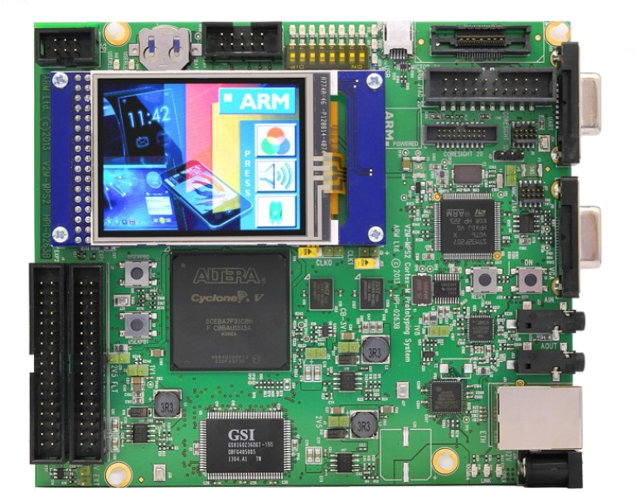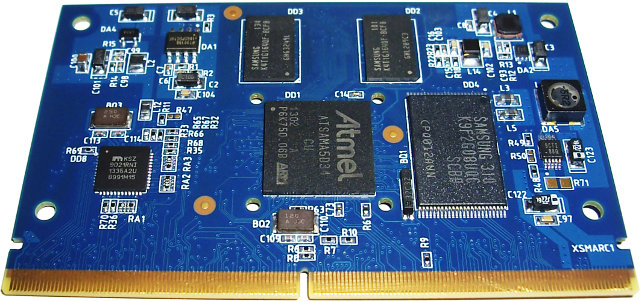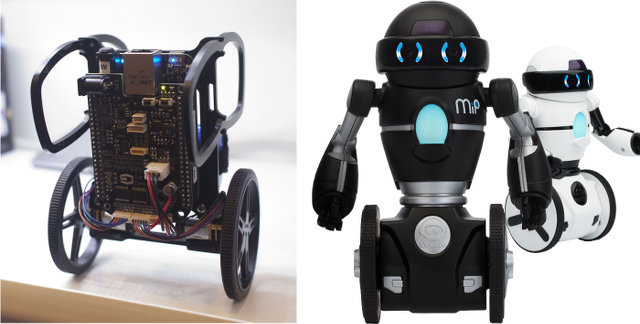A few months ago, AMD published a roadmap showing AMD “Seattle” Server CPUs based on ARMv8 64-bit architecture were planned for H2 Q2014. The company has now announced the first series of processors that will be based on ARM Cortex A57: AMD Opteron A1100 Series, as well as the corresponding development platform at the Open Compute Project Summit in San Jose, California. Key features of AMD Opteron A1100 Series processors: 4 or 8 core ARM Corte-A57 processors Up to 4 MB of shared L2 and 8 MB of shared L3 cache Configurable dual DDR3 or DDR4 memory channels with ECC at up to 1866 MT/second Up to 4 SODIMM, UDIMM or RDIMMs 8x lanes of PCI-Express Gen 3 I/O 8x Serial ATA 3 ports 2x 10 Gigabit Ethernet ports ARM TrustZone technology for enhanced security Crypto and data compression co-processors On the software side, the company mentionned it is a […]
Asus ZenFone Android Smartphones Powered by Intel Atom CPU to Sell for as Low as $99
Last year, Lenovo sold Android smartphones based on Intel Atom SoC but sales numbers turned out to be disappointing. This year, Asus announced 3 smartphones powered by Intel Atom Z2520 and Z2580 SoC at CES 2014, with screen sizes ranging from 4″ to 6″, and much more aggressive pricing, as the 4″ version will sell for $99, the 5″ version for $149, and the 6″ version for $199. Asus ZenFone 4/5/6 Specifications: SoC ZenFone 4 – 1.2GHz Intel Atom Z2520 CPU with Quad-Thread Hyper-Threading Technology ZenFone 5/6 – 2GHz Intel Atom Z2580 CPU with Quad-Thread Hyper-Threading Technology System Memory – 1GB RAM Storage – 8 or 16 GB NAND Flash + micro SD card slot (Up to 64GB ) Display ZenFone 4 – 4″ WVGA 800 x 480-pixel TFT display ZenFone 5 – 5″ HD 1280 x 720-pixel IPS display ZenFone 6 – 6″ HD 1280 x 720-pixel IPS display Camera […]
How to Install XBMC on D-Link Boxee Box
D-Link Boxee Box is a Linux based media player powered by Intel Atom CE4100 processor that became available in 2010, and features a dual sided RF remote / QWERTY keyboard that probably inspired many of the air mouse that are available today. The box features many of the ports and connectors that are available on most Android STB today, namely an HDMI port, an optical S/PDIF) out, a stereo analog audio out, Ethernet and 802.11n Wi-Fi, two USB ports, and an SD card slot. Many people however got disappointed with the firmware at launch time, and even if subsequent firmware updates have improved the user experience, some people have considered it was worth the effort to port XBMC to the device. Myles McNamara wrote the instructions to install XBMC on D-Link Boxee Box. I’ll summarize the steps below, and it appears to be relatively easy. Installing Boxee+Hacks to gain root […]
Cheap Accessories for Raspberry Pi – Camera, microSD adapter, Debug Board, Heatsink and Enclosure
The Raspberry Pi just a great low cost ARM Linux board that costs $25 (Model A) to $35 (Model B), but once you start to add accessories the total cost of ownership may creep up quickly, and in some cases accessories may be more expensive than the board itself. I’ll list some alternative accessories that can be purchased online for a fraction of the cost of the more famous one. $18 Raspberry Pi Camera The official Raspberry Pi camera costs $25 + shipping and tax, but you can get a similar 5MP CSI camera for just $18.13 including shipping on Banggood.com. This camera clone should be software compatible with the original one according to the listed features: Plugs directly into the CSI connector on the Raspberry Pi 5MP resolution image (2592 x 1944), or 1080p HD video recording at 30fps 5MP (2592 x 1944 pixels) Omnivision 5647 sensor in a […]
ARM Unveils Cortex-M Prototyping System Based on Altera Cyclone V FPGA
Before micro-controllers or processors are manufactured, simulation is performed in (usually) expensive boards based on FPGA chips from Altera or Xilinx, and once designers have found the system to work as expected, they can move to the next phase and work on the actual silicon. ARM has just released V2M-MPS2 Cortex-M Prototyping System for MCU / SoC / ASIC designers working on Cortex-M processors. Key features: Altera Cyclone V FPGA with ~150K LE 4x 2MB ZBTRAM (32-bit each, with two of them forming a 64-bit memory). ZBT = Zero Bus Latency 16MB PSRAM (16-bit) Touch screen LCD module Range of hardware interfaces – UART, VGA (4 bit per color), SPI, audio (I2S), Ethernet, LEDs, buttons I/O expansion ports (GPIO) FPGA images for Cortex-M processors Example project for Cortex-M0 DesignStart (processor IP has to be licensed separately) USB connection for downloading FPGA images and program image to micro SD card on board […]
AXONIM Devices Announces AXSY-SoM-SAMA5D3 System-on-Module Powered by Atmel SAMA5D3x Cortex-A5 Processor
AXONIM Devices, a company based in the republic of Belarus, announced AXSY-SoM-SAMA5D3 System on Module (SOM) powered by Atmel SAMA5D3x Cortex-A5 processor. This SoM targets industrial applications and supports low power application such as POS-terminals, handheld devices, medical devices and more. Here are AXSY-SoM-SAMA5D3x SOM specifications: SoC – Atmel ATSAMA5D3x ARM Cortex-A5 processors @ 536 MHz (SAMA5D31, SAMA5D33, SAMA5D34, SAMA5D35, or SAMA5D36) System memory – 128/256/512 MB DDR2 Storage – 256MB/512MB/1GB NAND, 1 to 8MB SPI Flash Interfaces: 6x UARTs, 3x I2C, 2x SSC (for I2S Audio CODECs), 2x SPI, 2x CAN 2.0B 1x USB OTG 2.0 High Speed, 3x USB 2.0 High Speed Host 1x 10/100/1G Ethernet (Gigabit PHY on board), 1x 10/100 Ethernet (with IEEE1588v2 support) 1x Memory BUS (EBI) LCD 24 bpp TTL 3x MMC/SD 4x PWM 1x RTC 1x SMD (SmartHSFe Modem Device) – Conexant CX20548 with SmartDAA technology support Power supply – 3.3V / 5V […]
The Open Source Robots Invasion Has Begun: BeagleMiP, uARM, and PiddyBot
In the last few days, I’ve come across three affordable open source robots either based on BeagleBone Black, or Arduino compatible boards, and I’m sure there are many other projects out there for people interested in getting started with robotics without breaking the bank. BeagleMiP Self-balancing Robot I’ve found out the first robots from a long armdevices.net video showing two Mobile Inverted Pendulum (MiP) robots, able to stand on two wheels, designed by the Coordinated Robotics Lab of The University of California, San Diego: BeagleMiP educational robotics development kit from Strawson Design. The kit features the BeagleBone Black board with Texas Instruments Sitara ARM Cortex A8 processor and Novus Robotics Cape, an add-on board that provides 9-axis IMU (Accelerometer, Gyro, Magnetometer), 6 PWM connectors to power servos or brushless ESCs, 2 user-accessible buttons and 2 LEDs, a cell balancer & overvoltage protector, H-bridges to drive 6 DC Motors, and connectors […]
Intel “Bay Trail” NUC (Next Unit of Computing) mini PC is Now Available for $140
Next Unit of Computing (NUC) is a small form factor PC designed by Intel featuring “low power” Intel CPUs. It has gone through different iteration starting with Sandy Bridge Celeron CPU, then Ivy Bridge Core i3 and Core i5 processors in the second generation, with the third generation using the Haswell architecture. Intel latest model called Intel DN2820FYK NUC is based on “Bay Trail” Celeron N2820 dual-core processor @ 2.4 GHz with 7.5W TDP, and is now available for $140 on Amazon. Intel DN2820FYK NUC specifications: Processor – Intel Celeron N2820 dual core processor @ up to 2.4GHz dual-core with 1MB cache, 7.5W TDP Memory – 1x DDR3L SODIMM 1.35V, 1333/1600 MHz (down clocked to 1066 MHz), 8GB maximum Storage – Internal support for 2.5¨ HDD or SSD Graphics – Intel HD Graphics @ up to 756MHz Video Output – 1x HDMI 1.4a Audio I/O – Up to 7.1 surround audio […]


